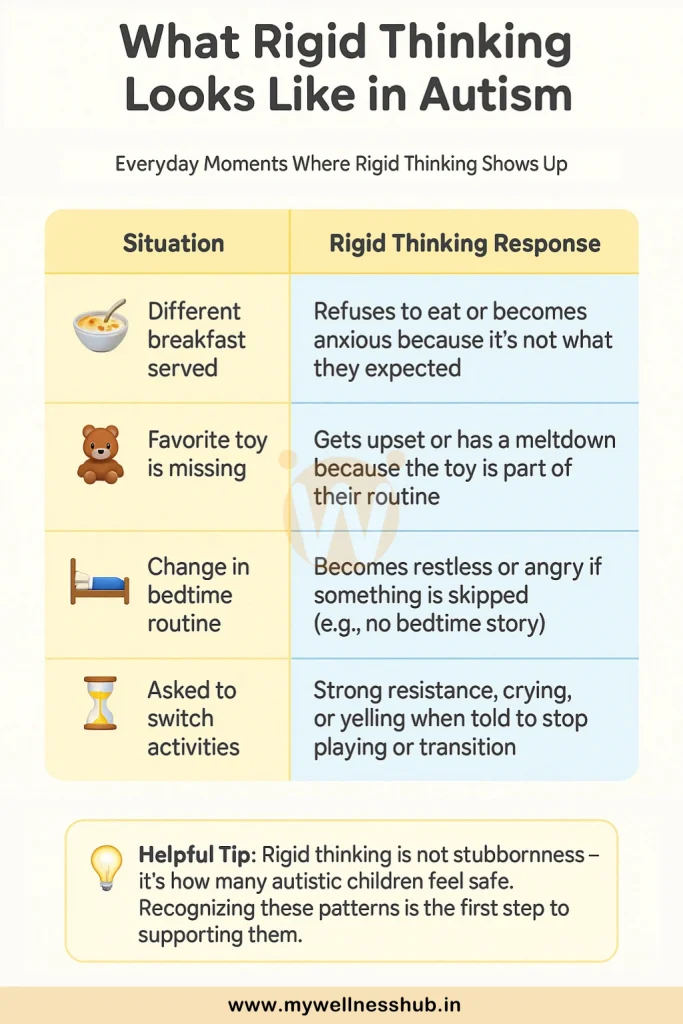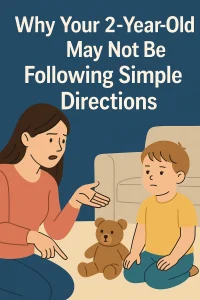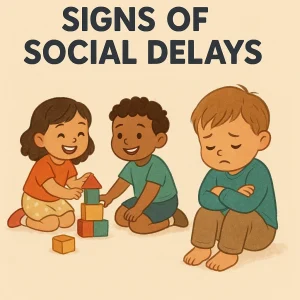Rigid Thinking in Autism: Why Change Feels Hard
Last Updated: May 10, 2025
For many children with autism, change isn’t just uncomfortable—it can feel overwhelming. Whether it’s switching activities, taking a different route to school, or trying a new food, even small changes can lead to big reactions. This is often due to rigid thinking, a common trait in autism that makes routines feel safe and necessary.
In this article, we’ll explore why routines matter, why change is hard for autistic children, and how parents can gently support flexibility over time. You’ll also discover helpful tools, real-life examples, and expert strategies from Wellness Hub to make daily life smoother for your child.
Book Free Autism Session
Concerned about your child’s development? Talk to our autism expert online for free. Get personalized consultation and expert next steps.
What Is Rigid Thinking in Autism?
If you’ve ever noticed your child getting upset when their routine is interrupted, refusing to switch from one activity to another, or insisting that things must be done “just so,” you may be seeing signs of rigid thinking in autism.

What Does Rigid or Inflexible Thinking Mean?
Rigid thinking (also known as inflexible thinking) refers to difficulty in adapting to new situations, ideas, or changes in routine. Children with autism often see the world in a very structured and predictable way. When that structure is disrupted, it can feel overwhelming, even scary.
Instead of being able to “go with the flow,” they may:
- Insist on doing things the same way every time
- Struggle when plans change suddenly
- React emotionally to unexpected events
- Need time to mentally prepare for transitions
This kind of thinking is not about being stubborn—it’s often how a child with autism processes and makes sense of their world.
Examples of Rigid Thinking in Autistic Children
Here are some real-life examples many parents will recognize:
| Situation | Rigid Thinking Response |
|---|---|
| Dinner is served later than usual | Child refuses to eat or gets anxious |
| A favorite shirt is in the wash | Refuses to wear anything else |
| You take a different route to school | Meltdown or repeated questions |
| A toy is missing or out of place | Becomes upset or distressed |
| Asked to switch from playtime to bath | Strong resistance or emotional outburst |
How Rigid Thinking Affects Daily Life
While routines can be comforting for all children, for those with autism, inflexible thinking can impact:
- Family routines – difficulty adjusting schedules or making spontaneous plans
- Learning – struggles in school when tasks or rules change
- Friendships – challenges with sharing or group play
- Emotional regulation – more frequent meltdowns when expectations aren’t met
This is why flexibility is often a key goal in therapy—it helps children become more adaptable and comfortable in daily situations.
Why Do Children with Autism Prefer Routine?
Have you ever noticed how your child seems happiest when things follow the same order every day? Whether it’s brushing teeth before bed or eating the same breakfast every morning, many autistic children find comfort in routine—and there’s a good reason for that.
The Comfort of Predictability
For children on the autism spectrum, the world can often feel unpredictable and overwhelming. Routines offer a sense of structure—a way to understand what comes next and what to expect.
When things happen the same way every time, it brings a feeling of safety and control. Predictability in autism isn’t just a preference—it’s a coping tool.
Why predictability matters:
- Reduces the fear of the unknown
- Helps children feel more in control
- Builds confidence in navigating daily life
- Creates a stable emotional foundation
The Role of Sensory Processing and Executive Functioning
Two things play a big role in why routines matter so much in autism:
- Sensory processing issues
- Executive functioning difficulties
| Factor | Impact on Routine Dependency |
|---|---|
| Sensory Processing | Loud sounds, strong smells, or unexpected touches can be overwhelming. Predictable routines help avoid sensory overload. |
| Executive Functioning | This includes planning, organizing, and shifting attention. Routines make it easier for children who struggle in these areas to move through daily tasks. |
Real-Life Examples of Routine Dependency
Here are a few everyday situations where a love for routine shows up:
- Same bedtime routine every night – even skipping one step can cause distress
- Eating the same food daily – changes in texture or brand may lead to refusal
- Lining up toys in a specific way – rearranging them can lead to frustration
- Watching the same video repeatedly – it’s not just fun, it’s familiar and soothing
- Following a strict order of dressing – like socks before pants, every time
These behaviors are common and deeply rooted in how autistic children experience the world.
Why Change Is So Hard for Autistic Children
If your child struggles with even small changes—like a new seat at the table or a change in their bedtime routine—you’re not alone. For many autistic children, resistance to change is more than just a dislike. It’s a deep emotional response that’s rooted in how their brain processes the world.
Fear of the Unknown
Imagine walking into a room where nothing is where it should be—new sounds, new people, new rules. That’s how change can feel for an autistic child. The fear of the unknown is real and overwhelming.
Without clear expectations, a child may feel:
- Confused or unsure of what to do
- Scared something bad might happen
- Out of control in an unfamiliar situation
This is one of the biggest reasons change feels unsafe. Routines give comfort; change removes that safety.
Difficulty with Transitions
Moving from one activity to another—whether it’s turning off a favorite cartoon or getting ready for school—can be extremely hard. These transitions feel abrupt, especially when they’re unexpected.
Common transition challenges include:
- Shifting from play to mealtime
- Ending screen time
- Moving between home and school environments
- Starting new tasks or stopping halfway
For kids with autism, transitions require mental preparation. Without it, they may feel lost or frustrated.
Sensory Overload and Unexpected Events
Many autistic children already deal with sensory sensitivities. Loud noises, bright lights, strong smells, or sudden touches can feel painful or overstimulating. When change introduces new sensory input, it can lead to sensory overload.
Here’s how it connects:
| Trigger | Sensory Response | Possible Behavior |
|---|---|---|
| New classroom environment | Bright lights, new sounds | Anxiety, withdrawal |
| Different clothes or textures | Itchy or unfamiliar feel | Refusal to wear or distress |
| Changed daily plan | Unpredictable events | Meltdown or shutdown |
When too much hits at once, the child’s system can’t keep up—and that’s when big emotional reactions happen.
Emotional Reactions and Meltdowns
When a child faces change they can’t process, it often leads to meltdowns. These aren’t tantrums or attention-seeking behaviors. They’re outbursts caused by emotional overload—a way of saying, “This is too much for me.”
Signs of meltdown due to change:
- Crying, screaming, or yelling
- Hiding or running away
- Hitting, biting, or self-injury
- Shutting down and going quiet
As a parent, it can be hard to witness—but these reactions are a call for support, not punishment.
Common Rigid Behaviors Seen in Autism
Every child has their quirks—but for children on the autism spectrum, some behaviors go beyond personality. They follow a pattern of thinking and reacting that feels fixed and repetitive. These autistic thinking patterns are not signs of stubbornness—they’re how many autistic kids make sense of the world.
Repetitive Actions and Limited Interests
Repetition is one of the most well-known features of autism. You might see your child:
- Flapping their hands or rocking back and forth
- Repeating the same phrase again and again (called echolalia)
- Watching the same scene from a video over and over
- Following a daily routine in the exact same order
These actions are often comforting to your child. They create a sense of rhythm and control, especially when things around them feel unpredictable.
Sometimes, a child may also show very strong interests—but in a limited range. For example, they might be completely focused on trains, animals, or numbers, and talk about little else.
Also read: Understanding Echolalia: 10 Key Differences in Speech Disorders
Trouble Adapting to New Situations
For children with autism, change can feel like a threat. Even small shifts—like visiting a new park or having a different teacher—can cause distress.
You may notice:
- Refusal to participate in unfamiliar settings
- Withdrawal or silence in new environments
- Emotional outbursts when something is changed last minute
This kind of response is tied to rigid thinking—it’s hard for the brain to switch gears quickly. That’s why helping your child prepare ahead of time can make a big difference.
Fixation on Specific Topics or Objects
It’s not just about what your child loves—it’s about how intensely they focus on it. Many autistic children develop fixations that become central to their daily lives.
You might see them:
- Insist on carrying a certain toy everywhere
- Talk nonstop about one topic
- Get upset if that interest is interrupted
- Memorize facts about their favorite thing and repeat them often
Strict Rules in Play or Social Interaction
Play might seem fun and flexible for most children—but for kids with autism, it often follows strict rules.
They may:
- Refuse to let others change how a game is played
- Insist on things being done “their way”
- Get upset if peers don’t follow their imaginary rules
- Struggle with cooperative or pretend play
How Parents Can Help: Simple Strategies for Managing Change
Supporting an autistic child through change doesn’t mean removing all routines—it means learning how to make change feel safe and predictable. With a few simple strategies, you can help your child feel more confident when things don’t go as planned.
Whether it’s switching from playtime to bath time or preparing for a family trip, these tools can go a long way in managing rigid behavior in autism and helping your child adapt to new routines.
Use of Visual Schedules
Many children with autism are visual learners. A visual schedule—using pictures, icons, or simple drawings—can help your child see what’s coming next.
Benefits:
- Makes routines more understandable
- Reduces anxiety about transitions
- Gives a sense of control and independence
You can create a visual schedule for:
- Morning routines
- Therapy sessions
- Weekend plans
- Daily chores
Even small children can follow these with ease—and you can find free printable templates or apps that make it simple to get started.
Give Advance Notice Before Transitions
Transitions are hard when they happen suddenly. One powerful strategy is giving your child a heads-up before a change.
Try saying:
- “In 5 minutes, we’ll stop playing and get ready for bed.”
- “After lunch, we’ll go to the doctor.”
- “Tomorrow, your teacher will be someone new.”
Use timers, countdowns, or even transition songs to make this more fun and predictable. This helps reduce the shock of change and gives your child time to mentally prepare.
Create Flexible Routines Gradually
You don’t need to remove routines—but you can build flexibility into them slowly.
Start with small changes like:
- Swapping the order of two safe activities
- Changing the color of a cup at snack time
- Introducing a new toy or book during a familiar routine
The goal isn’t to cause stress—it’s to help your child build confidence in handling small changes, so they can manage bigger ones later.
Use Social Stories or Role-Playing
Social stories are short, personalized stories that explain a new situation in a clear and comforting way. They often include:
- What the situation is
- How it might feel
- What the child can do
- Reassurance that things will be okay
Example: A story about visiting a new dentist, with simple pictures and calming language.
Role-playing also helps your child practice change in a safe, playful way. You might pretend you’re going to a new park or trying a new food—so your child can explore the idea without pressure.
Gently Expose Your Child to Small Changes
Start slow. Introduce small, manageable changes in daily life to help your child build resilience. These can include:
- Taking a different route to school once a week
- Letting someone else serve food at dinner
- Wearing a new shirt during a familiar activity
If your child struggles, that’s okay. Talk them through it, celebrate small wins, and provide lots of positive reinforcement.
Tools and Therapy Support for Rigid Thinking
When your child struggles with change, you’re not alone—and the good news is, there are effective ways to help. From early intervention to at-home tools, several autism strategies for change can gently support your child’s growth. With the right approach, even rigid thinking patterns can become more flexible over time.
The Importance of Behavioral Therapy and Early Intervention
Early support can shape how a child with autism learns to respond to change. Behavioral therapy, especially approaches like ABA (Applied Behavior Analysis), focuses on:
- Building flexible responses to new situations
- Rewarding adaptive behaviors
- Reducing anxiety tied to routine changes
The earlier the support starts, the more progress children often make. Therapists break goals down into small steps and teach skills through gentle repetition—perfect for kids who thrive on structure.
Early intervention programs also help children build emotional regulation skills, which makes managing change much easier in the long run.
How Speech Therapy Can Support Cognitive Flexibility
While many parents think of speech therapy as just talking, it also helps with thinking patterns and social understanding.
Here’s how speech therapy supports flexibility:
- Teaches turn-taking and sharing in conversations
- Helps children understand that there’s more than one “right” answer
- Uses role-play to prepare for different situations
- Encourages storytelling and thinking from others’ perspectives
Creating Structured Environments at Home and School
Children with autism thrive in environments that feel predictable—but predictability doesn’t have to mean rigidity.
A structured environment includes:
- Clear routines with visual schedules
- Consistent rules and boundaries
- Safe spaces for calming down
- Gradual exposure to new experiences
Conclusion
Autistic children feel safe with routines. But with gentle steps, they can also learn to handle change. Start small—one change at a time—and use tools like visual schedules and social stories. Always give your child time to adjust. You don’t have to do it alone. At Wellness Hub, we support parents with online autism therapy and parent coaching. Start with a free consultation—we’ll help you take the first step. Because small changes can lead to big progress.
Frequently Asked Questions:
1. Why do autistic children like routines so much?
Children with autism often find the world confusing and unpredictable. Routines give them a sense of order and control. When they know exactly what will happen next—like what time they’ll eat or when they’ll go to bed—it makes them feel safe. This is why many autistic kids prefer doing the same things every day, in the same way.
2. Why does my autistic child get upset when plans change?
For many children with autism, change feels scary. When something unexpected happens—like a new teacher, a canceled trip, or a different breakfast—it breaks their pattern. Their brain may not adjust quickly, which can lead to anxiety, stress, or meltdowns. Preparing them in advance can help reduce this response.
3. What is rigid thinking in autism?
Rigid thinking means your child may have trouble being flexible. They may want to follow certain rules, stick to routines, or do things in a specific order. For example, they might always want the same cup or insist on watching the same video. This kind of inflexible thinking in autism is common and often linked to how they process the world.
4. How can I help my autistic child adapt to new routines?
Start with small changes and build up slowly. Use visual schedules to show your child what the new routine will look like. Give them warnings before transitions (like “5 more minutes before we go”). Social stories and pretend play can also prepare your child for what’s coming. Patience and praise go a long way.
5. What causes meltdowns during transitions?
Meltdowns happen when a child’s brain gets overwhelmed. Transitions—like stopping playtime or leaving the house—can be too fast or confusing. If the child doesn’t know what’s happening or feels rushed, they may cry, scream, or freeze. These meltdowns aren’t “bad behavior”—they’re signs your child needs help calming down and feeling safe.
6. Can therapy help with rigid behavior in autism?
Yes, absolutely. Online autism therapy can help your child become more flexible. Therapists use games, stories, and real-life practice to teach how to handle changes step by step. Over time, therapy can reduce anxiety and help your child learn new ways to cope when routines change.
7. What are common signs of routine dependency in autism?
Signs may include:
- Getting upset when routines change
- Wanting the same food, clothes, or bedtime steps every day
- Asking the same questions or repeating the same words
- Becoming anxious when things are out of order
This strong need for routine is a part of autistic thinking patterns and is very common.
8. How early should we start therapy for rigid thinking?
Early is always better. Starting early intervention—even at age 2 or 3—can help your child build skills before patterns become harder to change. The earlier your child learns how to handle change and transition, the more confident they’ll feel as they grow.
9. What are some daily tools to reduce stress around change?
You can try:
- Visual schedules to show daily plans
- Countdown timers or transition songs
- Letting your child choose between two options
- Practicing small changes during play
- Creating a calming space at home
These tools can help your child manage anxiety and feel more in control.
10. Where can I find support as a parent of an autistic child?
You don’t have to do this alone. At Wellness Hub, we support families through:
- Free consultations
- Personalized online therapy
- Parent coaching
- Resources that understand Indian parenting, culture, and values
We’re here to help you take the next step with confidence.
About the Author:
Shravanaveena Gajula
M.Sc ., Speech and Language Pathology (5+ years of experience)
Shravanaveena Gajula is a dedicated Audiologist and Speech-Language Pathologist with a BASLP and an M.Sc in Speech and Language Pathology. With experience spanning multiple settings, including Wellness Hub and Ashray Akruti, Veena specializes in a wide range of disorders from developmental issues in children to speech and language assessments in adults. Her expertise includes parent counseling, managing speech sound and fluency disorders, and creating individualized therapy programs. Veena is also PROMPT certified and an author of several insightful blogs on speech and language pathology, aiming to educate and assist caregivers in supporting their loved ones.
Book your Free Consultation Today
Parent/Caregiver Info:
Client’s Details:
* Error Message









